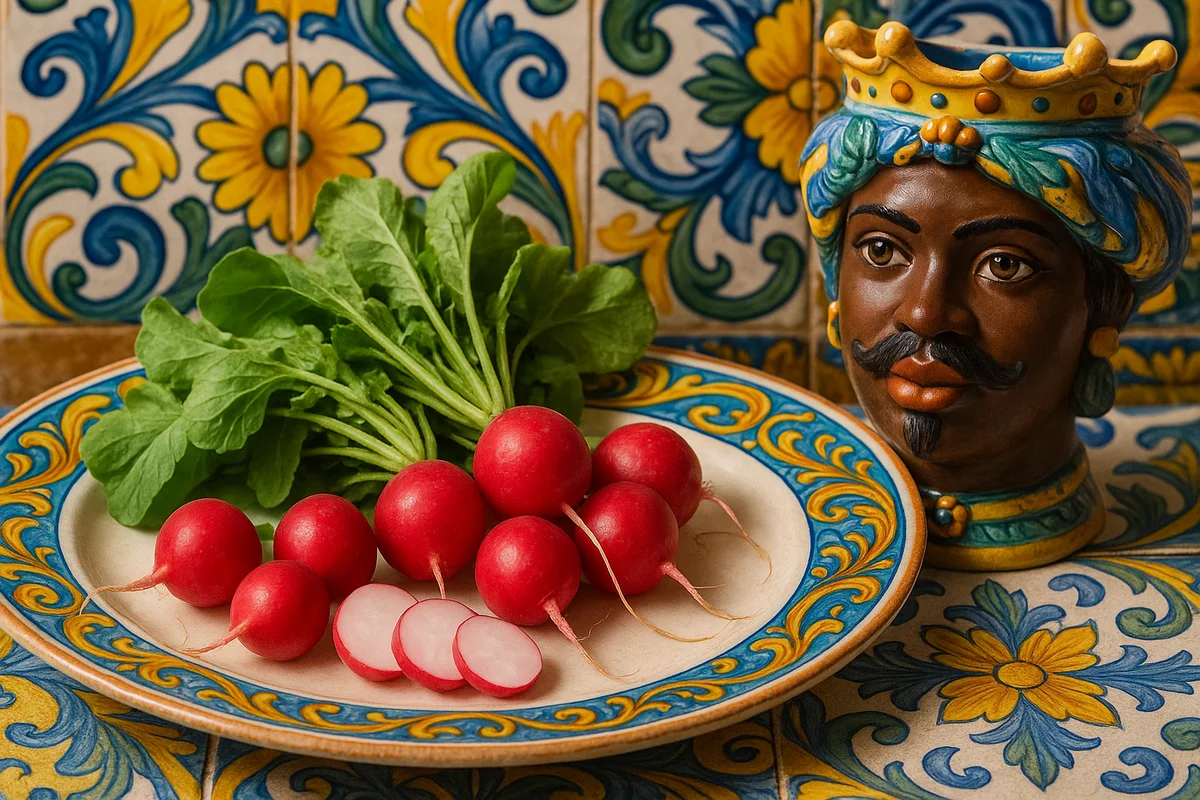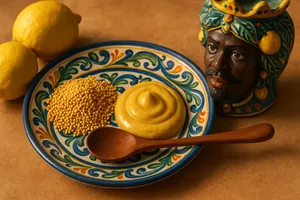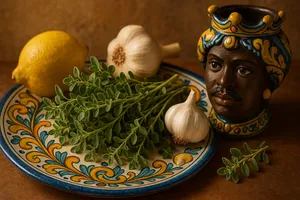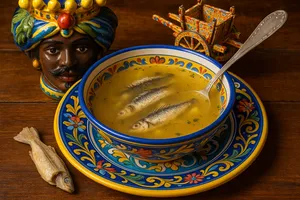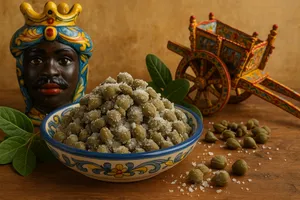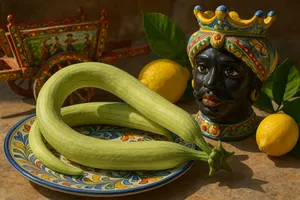Overview
Radishes are small root vegetables belonging to the Brassicaceae family, characterised by their round or elongated shape, bright red colour (in the most common varieties) or white, pink, or purple in others, and a lightly peppery, crisp flavour. They are eaten mainly raw in salads, as an appetiser, or simply with bread, butter, and salt following European tradition. In Sicily, radishes are not an ancient pillar of the local culinary repertoire like other vegetables (aubergines, tomatoes, peppers), yet they are cultivated and appreciated for the freshness and vibrancy they bring to spring and summer dishes.
The cultivation of radishes in Sicily is widespread in family gardens and horticultural fields, especially in coastal areas and fertile plains where they grow quickly thanks to the mild climate. They are among the fastest vegetables to mature (ready 3–4 weeks after sowing), easy to grow, and provide rapid, generous harvests. Fresh Sicilian radishes appear in spring and summer markets, sold in bunches with their leaves still attached (a sign of freshness). They are appreciated for their crisp bite, delicately pungent flavour that stimulates the appetite, and the bright colour they bring to dishes and salads. In contemporary Sicilian cookery, radishes are used creatively in mixed salads, as decorative garnish, or turned into pickles.
Characteristics
Radishes are generally round or slightly elongated (depending on the variety), measuring 2 to 5 cm in diameter and weighing 10 to 50 grams. The most common colour is vivid red with a white tip, though fully red, pink, white, purple, or bicoloured forms exist.
The flesh is white, crisp, juicy, and pleasantly firm. The flavour is fresh, lightly peppery (more or less intense depending on variety and freshness), with subtle spicy notes. The leaves are green, rough, and edible (though seldom used in Sicily).
Fresh radishes have firm, smooth, glossy roots and taut green leaves. Older radishes become soft, spongy, stronger in flavour, and lose their crunch. Freshness is essential to appreciate their qualities.
Varieties
Round red radishes
The most common type, with bright red round roots, often with a white tip. They have a medium peppery flavour, good crunch, and small to medium size. These are the classic market radishes.
French radishes (French Breakfast)
An elongated cylindrical variety, bright red with a pronounced white tip. They offer a milder flavour and an elegant shape appreciated for presentation. They are sweet and gently peppery.
White radishes
Entirely white, round or elongated, they have a milder flavour than red varieties and crisp flesh. They are less common but well regarded.
Black radishes (Black Spanish)
A winter variety with black skin, white flesh, round or elongated form, and larger size (up to 10 cm). They have a stronger, spicier flavour and keep well. They are less common in Sicily.
Long radishes (Daikon)
An Asian (Japanese) variety with long white roots reaching 30–40 cm. They have a delicate flavour, are widely used in Asian cuisine, and are becoming increasingly popular in Italy for innovative uses.
Cultivation
Radishes are among the easiest and quickest vegetables to grow. They are sown directly into the soil or pots from February to October (avoiding the hottest months for spring varieties). They prefer soft, well-drained, moderately fertile soil. Regular watering is needed to prevent them becoming woody or overly spicy.
Harvesting takes place 3–4 weeks after sowing, when the roots have reached the right size (2–3 cm in diameter for round varieties). They must be harvested promptly: if left too long in the ground they become spongy, hollow, fibrous, and excessively strong in flavour.
In Sicily, cultivation is practised year-round with suitable varieties: spring types from February to May, heat-tolerant summer types, and autumn varieties. Sicilian family gardens often include rows of radishes for quick, staggered harvests.
Seasonality
Radishes are available nearly all year, but the best periods are spring (March–May) and autumn (September–November), when mild temperatures promote optimal growth and sweetness. In summer, with excessive heat, they tend to become spicier and more fibrous. In winter, resistant varieties produce sweet, crisp radishes.
Culinary use
Raw radishes in salad
The most common use. Thinly sliced or quartered radishes enliven mixed salads with crunch, colour, and a lightly peppery note. They pair well with lettuce, rocket, carrots, and cucumbers.
Radishes with butter and salt
A classic French preparation, also appreciated in Italy: fresh whole radishes served with fresh butter and coarse salt. The radish is dipped in butter, then in salt, and eaten. A simple, refined appetiser.
Radishes with bread and ricotta
A Sicilian variation: thinly sliced radishes on bread with fresh ricotta, salt, and pepper. The sweetness of the ricotta balances the radish’s pepperiness.
Pinzimonio
Whole or halved radishes are excellent in pinzimonio: raw vegetables dipped in extra-virgin olive oil, salt, and pepper. They are a highlight of summer crudité platters.
Pickled radishes
Radishes can be preserved in vinegar: sliced or whole, marinated in vinegar, salt, sugar, and spices. They become sweeter and keep for months.
Cooked radishes
Less common but intriguing: radishes can be sautéed in butter with herbs or roasted in the oven. Cooking softens their pepperiness and lends sweetness. They feature in innovative cuisines.
Radish leaves
Young leaves are edible: they can be added to salads (with a lightly peppery taste), cooked like spinach, or used in soups. They are nutrient-rich but little used in Sicily.
Decorative garnish
Decoratively cut radishes (into flowers, roses, or fans) are an elegant garnish for cold dishes, buffets, and appetisers. Their vivid colour is much appreciated.
Preparation
Radishes require minimal preparation:
1. Rinse thoroughly under running water, gently scrubbing away soil.
2. Trim the fine rootlets and the leafy tops (keep the leaves if you intend to use them).
3. Eat whole, halved, thinly sliced, or julienned depending on the dish.
They do not need peeling: the skin contributes flavour and crispness. If the radishes are very large or have thick skin, they may be lightly peeled.
Storage
Fresh radishes keep in the fridge vegetable drawer for 5–7 days. It is best to remove the leaves before storing (as they draw moisture from the roots, causing faster wilting). Store them in a perforated plastic bag or a container with damp paper.
Radishes lose crispness over time: they are best eaten fresh. If they become slightly soft, they can be soaked in cold water for 30 minutes to partially rehydrate.
Pickled radishes keep for several months in sealed jars in the pantry (if unopened) or in the fridge (once opened).
Choosing radishes
Select radishes that are firm, smooth, glossy, and with intact skin free from blemishes or bruises. Leaves (if present) should be fresh and green, not wilted or yellowing (a sign of age).
Avoid radishes that are soft, wrinkled, with blackened areas or mould. Very large radishes may be hollow inside or fibrous: medium sizes are best.
In Sicilian spring markets, fresh radishes with leaves still attached indicate recent harvesting and good quality. Buy from local growers when possible for maximum freshness.
Nutritional properties
Radishes are low-calorie vegetables: 100 g provide around 15–20 calories. They are over 95% water, contain 1 g of protein, negligible carbohydrates, and virtually no fat. They are rich in vitamin C (about 15–20 mg per 100 g), potassium, calcium, iron, and phosphorus.
They contain sulphur compounds (glucosinolates) responsible for their peppery taste, with antioxidant, antibacterial, and detoxifying properties. Radishes stimulate digestion, are diuretic, and support liver function.
They are an ideal food for low-calorie diets, offering crunch and flavour without significant calories. They are easily digestible for most people, though excess may cause bloating in sensitive individuals.
Radishes in European tradition
Radishes have been cultivated and eaten in Europe for centuries. They are particularly appreciated in France (radis), Germany (Radieschen), and Eastern European countries. The French custom of serving radishes with butter and salt is iconic.
In Italy, radishes are widespread mainly in northern and central regions. In Sicily, their use is more recent and less rooted in tradition than other vegetables, yet it is growing with the spread of international cuisines and a growing appreciation for fresh, crisp vegetables.
Curiosities
The name “radish” derives from the Latin “raphanus” (itself from the Greek “raphanos”), meaning “that which appears quickly”, a reference to the plant’s rapid growth. It shares its name with horseradish (a different root from the same family).
Radishes are among the first vegetables children learn to grow in school gardens because they grow quickly and require little care. Seeing radishes emerge after only a few weeks offers immediate satisfaction.
In Japan, daikon (long white radish) is fundamental in traditional cuisine, eaten raw, pickled, cooked, or grated. It is one of the most cultivated and consumed vegetables.
Decoratively cut radishes (vegetable carving) are an art form in professional kitchens: flowers, roses, and fans are created with simple cuts. It takes practice but the effect is striking.
An old farming saying goes: “Radishes in March, pumpkins in August”, referring to the sowing calendar for year-round vegetables.
In some folk traditions, radishes were considered a remedy to stimulate appetite and aid digestion. They were served at the start of meals to “open the stomach”.
The pepperiness of radishes depends on several factors: variety, growing conditions (water stress increases pepperiness), and maturity. Young radishes are sweeter; those left too long in the ground become very spicy.
In Sicilian countryside gardens, radishes were often sown between rows of slower-growing vegetables (carrots, onions) to maximise space: the radishes grew and were harvested before the other crops needed the room. It is a clever companion-planting practice.

